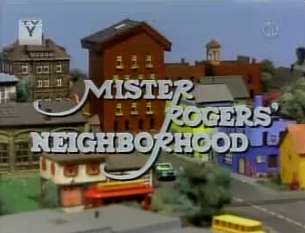
Maybe all it takes to change the world is a gentle voice, an understanding smile, and a familiar red sweater. Fred Rogers saw reflections of his influence in some big ways. Early one morning, the host and creator of Mister Rogers' Neighborhood parked his humble Impala on a street close to Pittsburgh's Public Broadcasting Station. After a day of taping he came out to the street to find his car was gone. Once he filed a police report, the story was picked up by every media source in the area. Within two days, Mister Rogers returned to the exact spot where his car had been stolen to find it parked and completely intact. Attached to the dashboard was a note that read, "If we'd known it was yours, we never would have taken it."
For nearly forty years, children between the ages of two and five began every day with Mister Rogers crooning "Won't you be my neighbor?" Those five simple words brought comfort to half of a century's worth of children while simultaneously changing children's educational television. Originally a Pittsburgh-based phenomenon, Mister Rogers' Neighborhood accrued national popularity. It is still aired on public broadcasting stations all over the country, becoming the longest running children's program on public television.
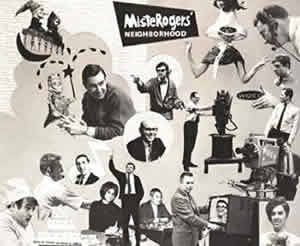
It all began in 1954 in Pittsburgh with Rogers' creation of The Children's Corner, which served as a prototype for the future Mister Rogers' Neighborhood and many of the show's puppet characters in the Neighborhood of Make-Believe. While living in Canada in 1963, Rogers developed a 15-minute segment of Mister Rogers' Neighborhood for Canadian television. WQED in Pittsburgh picked up the show as a half hour, regular series in 1968, leading Rogers back home to Pittsburgh. The final new episode aired in 2001, but more than 870 reruns still show weekly on public broadcasting stations.
The format of the show remained the same from 1968 to 2001. Each episode began and ended in Mister Rogers' television "house." This opening scene is where the ubiquitous "It's a beautiful day in the neighborhood" song, written by Mister Rogers' himself, was sung beginning every "visit" with the neighbors. Mister Rogers routinely changed into his sweater and boat shoes, making both him and his children neighbors as comfortable as possible. Throughout the episode he introduced his audience to guests, took field trips to places where adults worked, and met with people in the neighborhood. Often the guests were people of accomplishment over the decades, like musicians, artists, and athletes. Also, Mister Rogers' Neighborhood took breaks from reality to visit friends in the Neighborhood of Make-Believe. But at the conclusion of every episode, Mister Rogers returned "home" to remind his friends that he'd see them next time. And that's what he considered each and every member of the audience regardless of age, gender, race, or otherwise — his friends.
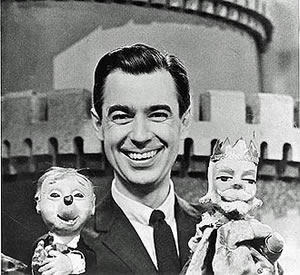
Mister Rogers' Neighborhood also remained consistent with regular characters, like the postman and friend Mr. McFeely, the neighbors in the Neighborhood of Make-Believe, and Fred himself. Children depended on daily visits with these characters, both human and otherwise. Rogers was acutely aware of the significance of the characters to his pre-school audience. Keeping his viewer's best interest in mind, Rogers intelligently separated the Neighborhood of Make-Believe from his real neighborhood. He accomplished this separation in a few ways. The passing of the red trolley always meant the viewers were traveling to Make-Believe. Most of the characters there were puppets, like Henrietta Pussycat, King Friday XIII, Prince Tuesday, Queen Sara, and X the Owl. Also, there were humans in Make-Believe and Rogers often provided the voices for the puppets, but Rogers never appeared in the fantastical neighborhood himself. Rogers was applauded by educators for his meticulous attention to the creation of a safe and comprehensible environment for children to learn.
But most importantly, every week Mister Rogers' show focused on a lesson or theme. The guests, field trips, songs, and the storyline of the Neighborhood of Make-Believe all had this common purpose. Most of the themes were concepts preschoolers are curious about like the arts, growing and changing, getting along with others, and rules. Children received explanations about the world around them from an adult who both loved and understood them. Mister Rogers did not limit his lessons to light topics though. He grappled with explaining issues as cumbersome as death, adoption, and with the changing times, even divorce. Unafraid to talk openly about serious issues, Mister Rogers was able to help children cope with challenging topics in an often scary world.
Mister Rogers' Neighborhood was different than most programming for children, mostly because it was intended to nurture feelings of love and kindness but still entertain and educate our preschoolers. As Fred Rogers told Jeff Greenfield in a CNN interview in 2001, "The whole idea is to look at the television camera and present as much love as you possibly could to a person who might feel that he or she needs it." In contrast to the loud noises and short clips in the slang-ridden, popular cartoon shows of today, Mister Rogers' spoke slowly, softly, and honestly to the young audience. The show fostered the belief that children should be respected and valued for their individuality and imagination. Professor of Education Robert Kastelic writes about the educational merit of the show in his article "Mr. Rogers and the Neighborhood As a Model for Understanding Human Behavior:" "The Mister Rogers' Neighborhood program might be considered by some as a self-esteem shot in the arm. While other programs place emphasis on presenting and learning the alphabet or numbers, this program places emphasis on being in control of one's feelings and learning how to live appropriately in the complex world we live in." Many adults are curious about the effectiveness of the show in an era when everything is fast-paced. But as Mister Rogers has successfully proven: the passing of a few decades cannot change the human condition. Forty years later, children still primarily require love and attention before trendiness or flashy toys.
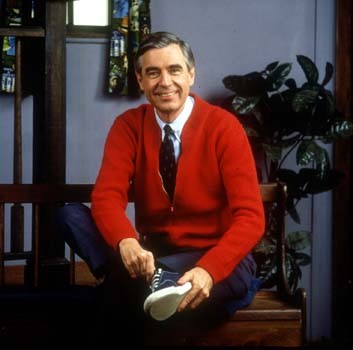
The portrayal of Mister Rogers as both warm and kind was not a television act. No horror stories exist of off-screen egotism or tyranny as with many national celebrities. When he appeared on screen for the nation, he appeared as himself. An ordained Presbyterian minister, Rogers truly cared for everyone he met. His co-worker and friend, Dave Newell, who played Mr. McFeely, confirms that, "He was so genuinely, genuinely kind, a wonderful person. His mission was to work with families and children for television_ÑÕ__That was his passion, his mission, and he did it from Day One." Rogers extended his work through Family Communications Inc., his own nonprofit production company that provides the resources for educators to continue the values taught in Mister Rogers' Neighborhood.
Along with such unconventionality and idealism came a healthy amount of good-natured ribbing. For Mister Rogers, the most famous parody of his show was Eddie Murphy's urban version called "Mister Robinson's Neighborhood" on Saturday Night Live. Mister Robinson was just like Mister Rogers in most ways; he sang, wore a sweater, spoke slowly and deliberately, but taught about things like eviction and being poor in a racist society. While it was clear that Murphy was making fun of the unrealistic perfection of Mister Rogers' world, the two men were fans of one another. Mister Rogers found the skit to be funny and knew Murphy did not intend to be hurtful. In fact, when Murphy finally met Rogers he gave him a hug and just said, "the real Mister Rogers."
As immortal as the show seemed to become, Mister Rogers' Neighborhood eventually stopped airing on a daily basis. Although the show kept running even after Mister Rogers died on February 27, 2003 (two years after he stopped airing new episodes), the show's daily spot was threatened soon after. The change came in September 2008 when PBS decided to air rerun episodes on a separate feed, which local stations could decide to air independently. Otherwise Rogers and his friends would appear only for one show on the weekends. Many stations have decided to terminate the daily feed of Mister Rogers and his gang due to declining ratings and pressure for fresh programming. PBS's decision has not gone without resistance. The Save Mister Rogers' Neighborhood campaign, initiated by Brian Linder, has turned attention back to the nurturing show many Americans grew up with. Linder, now a parent himself, reflects on the impact Rogers made in his own life: "I was a highly sensitive child. It was Mister Rogers who taught me how to begin to deal with my feelings. I think he taught my parents a lot, too. I know I'm still learning from him." Linder's mission is to remind people of the impact this long-running show has had on families, and to inspire people to take action to preserve it.
While our children are no longer receiving their daily dose of televised, individualized attention, many people like Brian Linder and organizations, such as Family Communications Inc., are making sure that the lessons of Mister Rogers' Neighborhood perpetuate in other ways. An interactive Mister Rogers' Neighborhood website is in progress as a safe and creative environment for children to learn and grow. Also in honor of the show's legacy, the Children's Museum in Pittsburgh sponsored a traveling Mister Rogers' Neighborhood exhibit in 1997, featuring replicas of the sets. An additional transient exhibit, "How People Make Things" began its road trip in 2007. Joyce Millman of Salon Entertainment realizes while exploring the set replicas, "This is Rogers' way of helping us remember the children we once were, to remember what we needed and wanted from our parents, what made us happy and secure: love, attention, consistency. It wasn't very much, and it was everything."
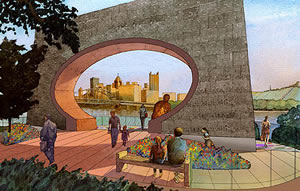
More permanently, the city of Pittsburgh plans to host a 10-foot sculpture of Rogers singing and tying up his shoes on a North Shore observation deck. A park will be built surrounding the statue, giving children a place to play with a view of the city behind them. The three million dollar project is being funded by Colcom Foundation, an organization raising overpopulation and environmental sustainability awareness. Rather than calling this a memorial to Fred Rogers, the city is proclaiming it a "Tribute to Children," hoping that it will provide an area for families to spend time together.
Mister Rogers, a man blessed with humility, once told us, "If only you could sense how important you are to the lives of those you meet; how important you can be to people you may never even dream of." Whether Mister Rogers had a sense of how many people he touched is hard to say. But those who were impacted by Mister Rogers know the warmth he channeled into the world continues, even if Mister Rogers' Neighborhood does not.
Sources:
- Kastelic, Robert. “Mr. Rogers and the Neighborhood As a Model for Understanding Human Behavior.” Skole: The Journal of the National Coalition of Alternative Community Schools. 15 (1998): 92-96.
- McCoy, Adrian. “New Children’s Museum exhibit follows Fred Rogers’ legacy”. Pittsburgh Post-Gazette 8 June 2007. 15 Oct. 2008 <http://www.post-gazette.com/pg/07161/792360-51.stm>.
- Millman, Joyce. “Fred Rogers.” Salon Brilliant Careers. 10 Aug 1999. 15 Oct 2008. <http://www.salon.com/people/bc/1999/08/10/rogers/>.
- “Fred Rogers dies at 74.” Post-gazette.com. 28 Feb. 2003. 10 October 2011. <http://www.post-gazette.com/ae/20030228rogersae1p1.asp>.
- Mister Rogers’ Neighborhood. 2008. PBS Kids. 15 Oct. 2008 <http://pbskids.org/rogers/>.
- Rogers, Fred. “Mr. Rogers Neighborhood To Air Last Show.” Interview. CNN Live at Daybreak. 31 Aug. 2001. CNN. 15 Oct. 2008 <http://transcripts.cnn.com/TRANSCRIPTS/0108/31/lad.09.html>.
- Save Mister Rogers’ Neighborhood. 07 Oct. 2008. Save Mister Rogers’ Neighborhood. 15 Oct. 2008 <http://www.savemisterrogers.com>.
